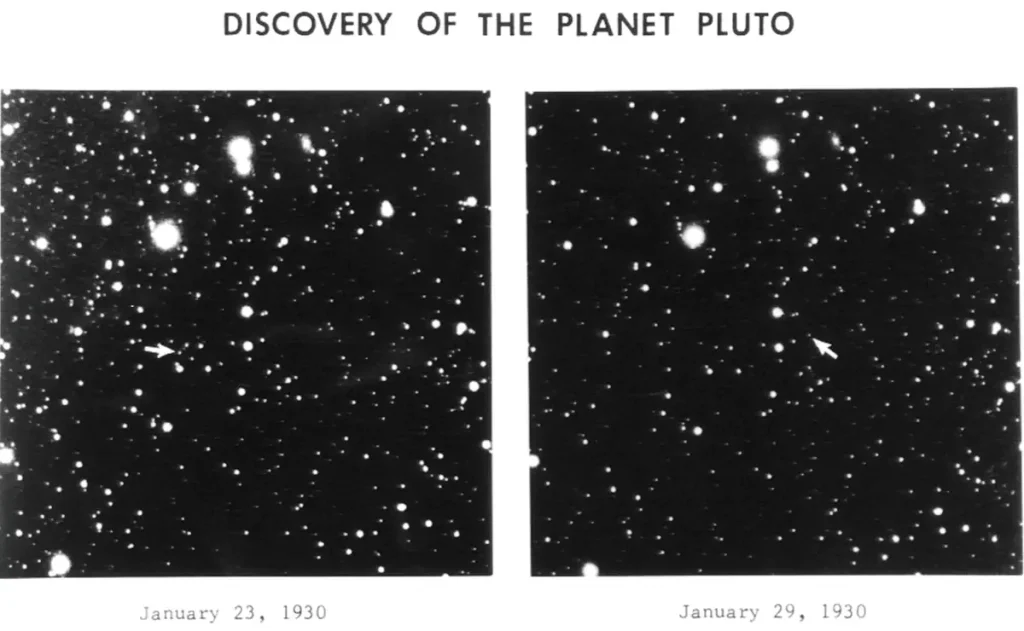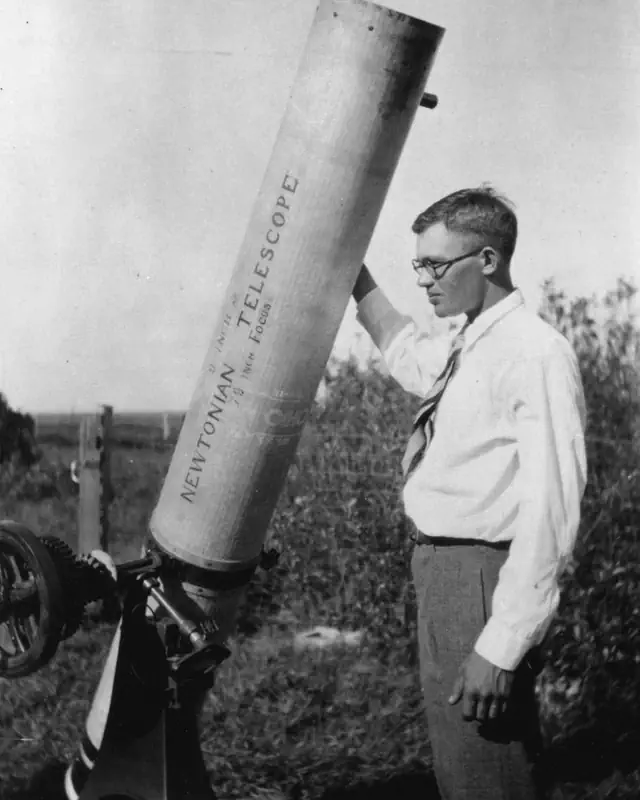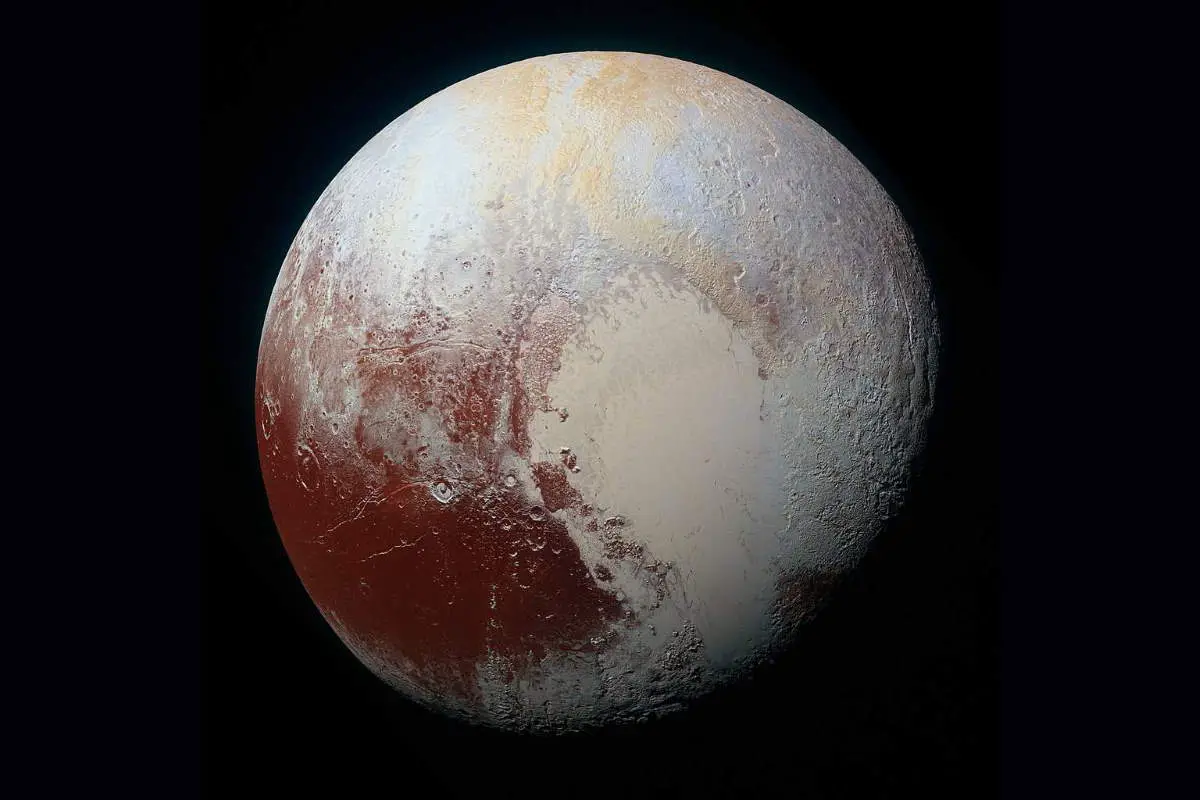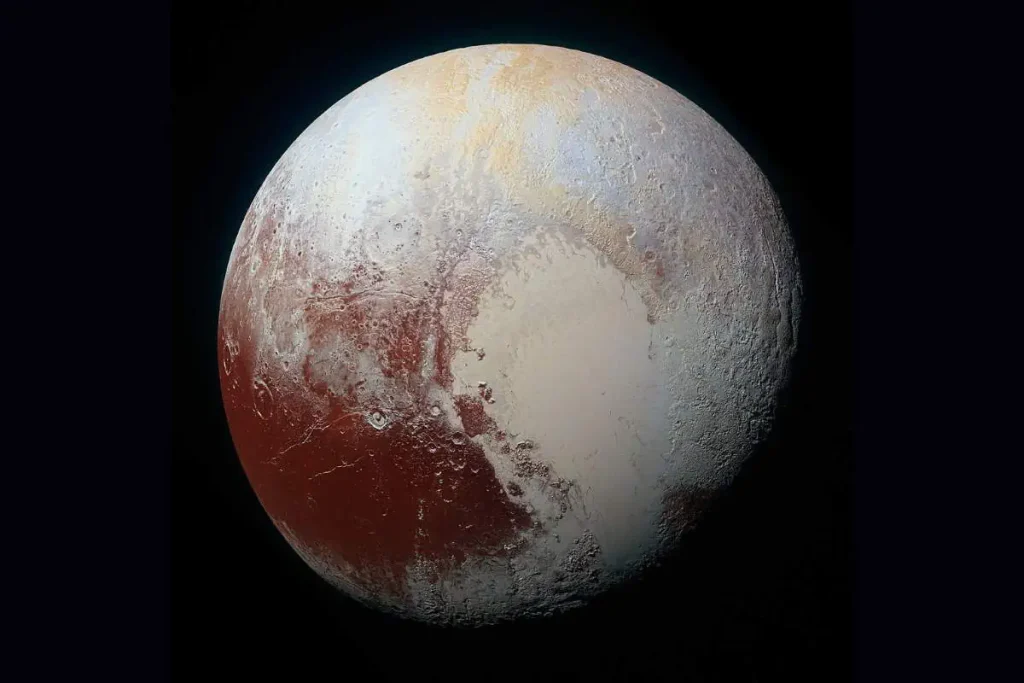Pluto was discovered on February 18, 1930, by the American astronomer Clyde W. Tombaugh (February 4, 1906 – January 17, 1997) at the Lowell Observatory in Flagstaff, Arizona.
Tombaugh was a self-taught astronomer who had been hired by the Lowell Observatory in 1929 to help with the search for a possible ninth planet in the Solar System.
The idea of a ninth planet beyond Neptune had been proposed by the American businessman, author, mathematician, and astronomer Percival Lowell (March 13, 1855 – November 12, 1916), the founder of the observatory, who had been searching for it until his death.
Lowell also fueled speculation that there were canals on Mars, but that turned out to be false.
The Quest for Planet X
Lowell hypothesized that the enigmatic Planet X affected the orbital paths of Neptune and Uranus. Pinpointing this hidden planet demanded complex calculations. In an era predating digital technology, these mathematical tasks were executed manually by human computers, a role frequently filled by women due to its perceived mundane nature. Elizabeth Langdon Williams, an MIT mathematician, wielding exceptional skill, steered this group of human calculators.
Guided by Williams, the team advised Lowell on the precise regions to focus his telescope, using the orbital variations of Neptune and Uranus. However, Lowell’s untimely passing in 1916 momentarily halted the project.
The quest picked up momentum in the late 1920s with American astronomer Clyde Tombaugh leading the charge. Building on Williams’ foundational work, Tombaugh detected an irregularity in a sky photograph, which culminated in Pluto’s official discovery in 1930.
How Pluto was discovered

Tombaugh used a blink comparator, a device that allowed him to compare two photographic plates taken at different times and identify any objects that appeared to move against the background of fixed stars. This was a time-consuming and tedious process, but Tombaugh was determined and persistent.
After several months of searching, on February 18, 1930, Tombaugh finally discovered a faint object that appeared to move against the background of stars on photographic plates taken on January 23 and 29. This object was later confirmed to be Pluto, the ninth planet in the Solar System at the time.
The discovery of Pluto was a major astronomical event and generated a lot of excitement and interest among the public and the scientific community.

Pluto was the first object to be discovered in what would later be identified as the Kuiper belt, a circumstellar disc in the outer Solar System, extending from the orbit of Neptune at 30 astronomical units (AU) to approximately 50 AU from the Sun. An astronomical unit (AU) is a unit of distance that is used to measure distances within our solar system. It is defined as the average distance between the Earth and the Sun, which is approximately 93 million miles (149.6 million kilometers).
However, over time, new discoveries led to a reclassification of Pluto as a “dwarf planet” rather than a full-fledged planet, and today it is considered one of the largest objects in the Kuiper Belt, a region of icy objects beyond the orbit of Neptune.
When will Pluto complete its first orbit since its discovery?
Pluto is located in the outermost region of our solar system and has an extremely elliptical and inclined orbit that takes it approximately 248.09 Earth years to complete one revolution around the Sun. This period is known as its “orbital period.” Pluto was discovered by Clyde Tombaugh on February 18, 1930. So, it still didn’t complete even a single orbit since its discovery.
Therefore, to estimate when Pluto will complete its first full orbit since its discovery, we simply add 248.09 years to 1930. This gives us the year 2178. However, the exact date within 2178 depends on the precise calculation of its orbital period and variations caused by gravitational interactions with other bodies in the solar system, among other factors.
Most probably, Pluto will complete its first full orbit since its discovery on Monday, March 23, 2178. In any case, humanity will have to wait until the late 22nd century to celebrate the first Plutonian year since its discovery.
How Pluto got its name
The name “Pluto” was suggested by an 11-year-old girl named Venetia Burney. She was the granddaughter of Falconer Madan (1851-1935), Librarian of the Bodleian Library of the University of Oxford.
On 14 March 1930, Falconer Madan read the story of a new planet’s discovery in The Times and mentioned it to his granddaughter Venetia. She suggested the name Pluto – the Roman God of the Underworld who was able to make himself invisible
Madan forwarded the suggestion to the British astronomer Herbert Hall Turner (13 August 1861 – 20 August 1930), who cabled his American colleagues at Lowell Observatory.
The astronomers loved the idea and the name “Pluto” was officially adopted by the International Astronomical Union on May 1, 1930.

The “Grave” Farthest From Earth belongs to Clyde William Tombaugh, Pluto’s Discoverer
Clyde Tombaugh passed away in 1997. Fast forward nearly twenty years, an extraordinary tribute to Tombaugh’s life and legacy took place. An aluminum capsule, containing one ounce of his cremated remains, embarked on an extraordinary voyage to the outer reaches of our solar system. This precious cargo was carried by the New Horizons spacecraft that visited Pluto back in 2015, and now heading to interstellar space, turning Tombaugh into an eternal voyager among the celestial bodies he dedicated his life to studying.
On the capsule, an inscription pays homage to Tombaugh’s multifaceted life – as a loving husband, a devoted father, an inspiring teacher, a noteworthy astronomer, a clever punster, and a cherished friend. This interstellar memorial immortalizes his contributions and ensures that his name continues to resonate in the cosmos he once explored from Earth.
The concept of space burials traces back to 1992, when the remains of Star Trek creator, Gene Roddenberry, were launched into space as a memorial. Since that pioneering event, approximately 450 individuals have had their ashes sent to space. However, it’s essential to note that these space burials typically involve only a small fraction of the person’s cremated remains – perhaps a gram or two – and they often embark on a short-lived journey to the stars.
Afterward, these remains generally return to Earth on the same spacecraft, or they are incinerated during reentry into the Earth’s atmosphere. Nonetheless, each space burial serves as a unique tribute, immortalizing the individual’s connection to the cosmos and perpetuating their memory among the stars.
Despite numerous space burials and explorations, it remains a fact that no individual’s final resting place has ventured deeper into the vast expanse of the universe than Clyde Tombaugh’s. His ashes, aboard the New Horizons spacecraft, have made a journey beyond the familiar boundaries of our solar system at a speed of about 16.26 km/s (10.10 mi/s; 58,500 km/h; 36,400 mph).
This unprecedented voyage symbolizes the pioneering spirit Tombaugh embodied throughout his life as an astronomer. His remains now traverse the void that he spent a lifetime studying, adding an additional chapter to his personal and professional legacy.
The emptiness of the cosmos, often perceived as desolate and solitary, is now Tombaugh’s silent yet profound testament. In this grand celestial theatre, Tombaugh’s memory endures, forever connected with the distant celestial bodies he dedicated his life to exploring. The profound journey of his remains, hurtling deeper into the unknown, embodies a poetic epitaph that speaks volumes of his impactful life. Indeed, no one has journeyed as far into the cosmic wilderness as Clyde Tombaugh.
Sources
- Clyde Tombaugh on Wikipedia
- Clyde Tombaugh on the NASA Starchild website
- Venetia Burney on Wikipedia
- “The Grave Farthest From Earth Is on a Spacecraft Headed Out of Our Solar System: Clyde Tombaugh discovered Pluto and then hitched a ride toward it.” on the Atlas Obscure website
- Moon Landings: All-Time List [1966-2025] - February 2, 2025
- What Is Max-Q and Why Is It Important During Rocket Launches? - January 16, 2025
- Top 10 Tallest Rockets Ever Launched [2025 Update] - January 16, 2025


